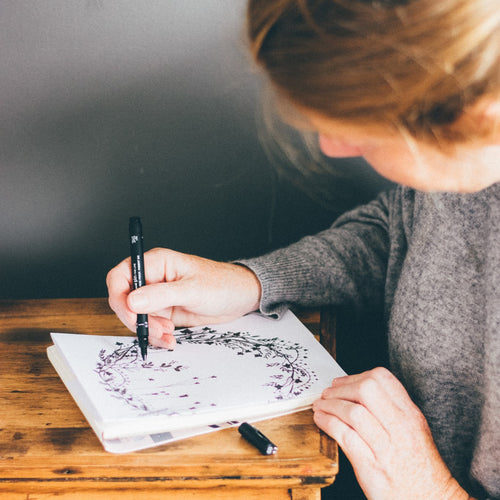The inspiration for our new folding sewing kit came from the “Huswif” which was originally an eighteenth century housewife’s tool kit, a small portable case containing sewing supplies which could be folded and carried in a pocket or workbag.
History of the Huswif
The Huswif was described in the Oxford English Dictionary of 1749 for the first time and seems to have originated from Lancashire in the UK.
Usually made from fabric scraps of linen, wool and cotton and edged in tape, it could be folded up or hung from a peg. More elaborate huswif’s used silk moire, damask, chintz, muslin and brocade and often embroidery was a feature of each huswif.
Who Made the Huswif?
These were often made by women and girls as a sampler or demonstration of sewing ability. It was an opportunity to learn basic stitches such as back stitch, basting stitch, hemming stitch, and blanket stitch. Young women created a practical, lovely and colourful storage place for their sewing tools.
Aside from being beautiful, their function as a holder of useful sewing suppliers meant that they were in constant use. Girls, in anticipation of their duties as wives and mothers, were taught to do plain, as well as sometimes intricate sewing, since once married, they would be expected to make all the clothing, pillow cases, bed sheets, and tablecloths by hand.
What Size Was the Huswif?
The huswif, was generally small, from 7.5-20cm (3-8 inches) wide and 30-60cm (12-24 inches) long. It was made of two strips of fabric with pockets stitched into one side across its width. Stored inside these pockets were snips or scissors, sewing needles, pins, threat, thread winders, thimbles, beeswax, buttons and measuring tape. The huswif folded in on itself and tied close to fit neatly into a pocket so that it was fully portable.
Jane Austen’s Sense and Sensibility makes mention of a huswif “And for my part, I was all in a fright for fear your sister should ask for the huswifes she had gave us a day or two before….” (Chapter 38)
There are some wonderful examples of Huswif’s that have survived the sailors and soldiers that carried them for mending their uniforms. Often made by their loved ones and given as a farewell gift; many were personalised with embroidery for men to take to war.
By the mid 19th century these sewing kits became standard army issue. Made from rolled up khaki, they contained thread, needles, thimble, buttons and scissors. The sewing needles could be used for sewing on buttons, removing splinters or at times to sew up wounds.
During both world wars, women’s sewing groups made and included these sewing kits in care packages and the “Huswife” became a standard army issue of the British Army up until the 1960s.
What Did We Draw On From The Huswif?
We loved the idea of having pockets to hold thread and other notions, including a useful pair of scissors and so we integrated two pockets in our own design. One pocket holds folding Rose Gold Scissors and the other two spools of thread, one black and one white.
We also wanted to make sure that the needles and pins had a secure storage place. To introduce a different texture and a little luxury, we created a blue velvet pad for a selection of pins, a Milliner's needle and a safety pin.
And most of all, we wanted to make sure that our lovely linen sewing kit was also practical and portable, like the original Huswif. Our sewing kit folds from the bottom up and is secured with a beautiful blue velvet ribbon.
We had lots of fun researching and designing our folding sewing kit and we hope that you've enjoyed hearing a little bit about the original Huswif and it's inspiration in developing our own sewing kit.
Making and mending is definitely on the rise in popularity, as people recognise again the value of being self sufficient enough to mend and alter clothes.
Whether you are a keen sewer or simply sew on the odd button, we hope that you enjoy using our sewing kit and have a deeper understanding of the inspiration for our new sewing kit.
If you are interested in crafts, why not explore our Slow Stitched Mini Quilt and Coasters Kits, developed in conjunction with textile artist Rebekah Johnston here.
If you have any questions or comments about this article, please get in touch and do please post pictures of your making and purchases on our social media pages. Find us on Facebook or Instagram.
To join our community and access all our free downloadable images and ideas, sign up to our newsletter here.
You'll also receive early notice of sales, new products, gift ideas, recipes, workshops, and events! So don't hesitate to sign up. Click here.









Leave a comment